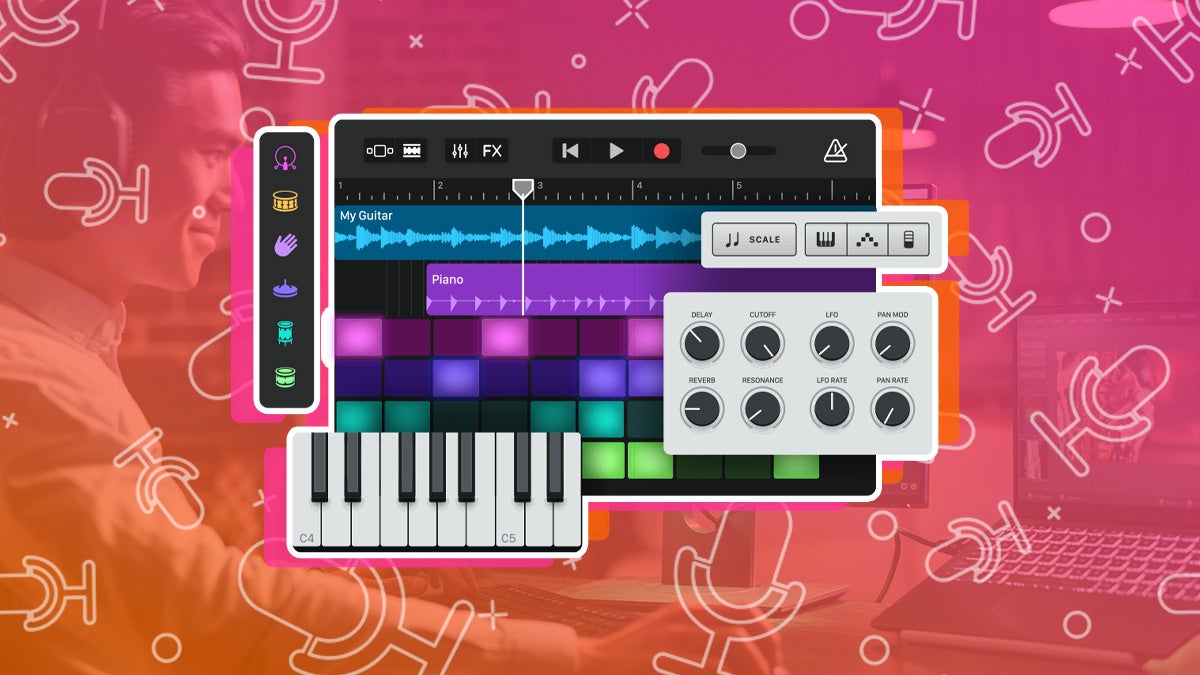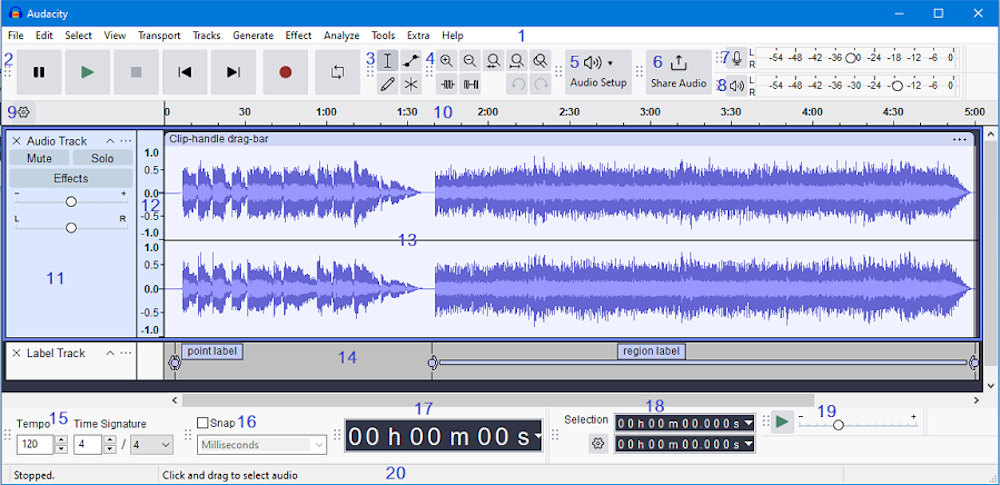
When assembling a podcast or other audio project by yourself, recording audio is just the start. Then, you’re going to need to edit it. Editing is where you make cuts, equalize levels, and make adjustments to make your audio flow better. You might also want to add sound effects, background music, and speech you’ve recorded after the fact. To do all that, you need audio editing software.
There are many options in audio editing software, ranging from free, barebones programs to expensive, professional-level suites. Here are our picks for some of the best audio editing options out there for most creators.
The Best Audio Editing Software For Any Budget
1) Best Free Audio Editing Software – Audacity

Price: Free!
Who it’s good for: Everyone, especially podcasters
Audacity is a free and open-source audio editor that’s been around since the year 2000. Its presentation isn’t much to look at, with its stripped-down, somewhat dated interface.
But you’re not here for sleek production values, you’re here for utility. Audacity is a great workhorse introduction to audio editing. A huge number of podcasters use Audacity to record and edit their audio. There’s also a great deal of documentation available to walk you through issues and difficulties.
Even beginners will find the basics of normalizing audio, trimming and making cuts, and adding fades quite easy in Audacity. Advanced editors will find plenty to work with here, too, as the software is highly customizable. Audacity saves to a project format but can export to WAV, MP3, AIFF, and all other major audio formats.
You might have heard some controversy around Audacity several years ago, when a proposal was drafted to allow the program to record its usage. At the time, it seemed like Audacity would be hurt by the perception it was becoming spyware. However, developer Muse Group dropped this proposal and Audacity remains one of the most popular audio editors out there.
2) Best Audio Editing Software for Beginners – ocenaudio

Price: Free
Who it’s good for: People just starting out with audio editing
If you’re just getting started with audio editing and you really only need to do simple tasks, then more complex editors can be overwhelming. ocenaudio is a great choice for the beginner who just needs to cut some audio together, apply some equalization, and export the finished audio.
It has a simple, straightforward interface, is compatible with Windows, Mac OS, and Linux, and is free to use. While you might not find all of the features of more advanced audio editing suites, it’s hard to argue with ocenaudio’s lack of price tag and ease of use.
3) Best Mac Audio Editing Software – GarageBand

Price: Free
Who it’s good for: Mac users, music creators
While many audio editing software works just fine on Mac, GarageBand is built from the ground-up for the Mac ecosystem. There are versions of the app for Mac OS and iOS. While there are some different features across the different versions, for dedicated Mac users GarageBand is a great start for audio editing.
The software has been free since 2017 and lets you perform all of the basics of audio editing with an attractive, intuitive interface to boot. As the name implies, GarageBand is mainly keyed towards making music, with plenty of loops, instruments, and other tools available to play around with.
Of course, as Apple’s free audio editing option, GarageBand isn’t as fully-featured as Logic Pro, their paid, professional DAW. That said, it’s still a great choice for Mac users who want audio recording and editing software that will work across all of their devices.
4) Best Budget Audio Editing Software – Cockos Reaper

Price: $60 for an individual license
Who it’s good for: Music producers
Cockos Reaper may have something of a silly name, but it’s a great piece of software. For music producers especially, Reaper is a fantastic deal. It’s not only efficient and quick-loading, it’s quite powerful, too.
It can import, record to, and export to a variety of different formats with nearly any sample rate you could ask for, has MIDI hardware and software support, and comes with a ton of different audio processing effects.
One of the best parts of Reaper is its customizability. It has custom skins, different layouts, and a ton of other options to get it looking and feeling exactly how you want it. And the customizability is more than skin-deep, too: Reaper has support for thousands of plug-in effects and instruments.
Reaper’s individual license costs $60. That’s all you’ll need if you’re an individual using it for personal use, or if you’re using it commercially and making less than $20,000 gross a year. If you’re making more than that, a commercial license will cost you $225.
5) Best High-End Audio Editing Software – Ableton Live

Price: Varies
Who it’s good for: Advanced users, music producers
If you have the cash to throw around and want to get a high-end audio editing experience, you might want to check out Ableton Live. This is a great choice for creators making music and especially electronic music.
Ableton has a huge number of valuable tools like automation lanes, a session view for easy composition, and nondestructive editing. In addition to audio editing, Ableton Live is also designed to be a live instrument, and is often used by professional DJs.
There are three versions of Ableton Live available: Intro, Standard, and Suite. Each has progressively more features and capabilities, with Intro (priced at $99) having the fewest and Suite ($749) having the most.
This is a premium product with a price to match, but you can try it free for a limited period of time, and there are also 12-month pricing plans available.
Other options in this category would be Adobe Audition or Avid Pro Tools. Both are powerful pieces of software, but are only available via monthly subscriptions rather than a one-time purchase, which makes them more difficult to recommend.
What is a DAW?
You’ll see the acronym “DAW” a lot while looking into audio editing software. It stands for “digital audio workstation” and can refer to a software suite or to a combination of software and audio editing equipment. Audio editing and DAWs can get very complex, but if you’re just starting out then you don’t need to worry too much about the technical details.
What File Format is Best for Podcasting?
For many podcasters, MP3 audio will do just fine. It’s true that MP3s are compressed down from raw audio files, but in the vast majority of cases this compression isn’t noticeable and is worth the vastly reduced file size.
That said, if you’re an advanced editor you may prefer to export your podcast as a WAV, and many podcasters work with WAV files while editing and then export to MP3 for publishing.
Conclusion
If you’re a content creator who is just starting out making podcasts or editing spoken audio for videos, then you shouldn’t feel the need to break the bank or dive into the world of complex editing software. Simple, easy-to-grasp tools like Audacity and ocenaudio should be more than good enough for your purposes.
If you need more dedicated tools for creating music, you might want to give something like GarageBand a try. Don’t be swayed into believing that spending money will make your work better.
Plenty of podcasts and other content are recorded and produced using simple software, and while higher-end, expensive products can be useful sometimes, you can always add them to your process down the line.




